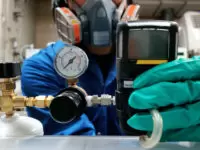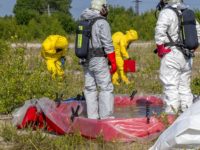
A paleoclimatologist examines climate data to understand how local ecology and global climate looked in the past.
What Does a Paleoclimatologist Do?
Climate science has been vital for understanding how our world is changing - in the oceans, the air and on the land. These research scientists collect data from a wide variety of sources to monitor the changes currently going on with our planet. With the data that climate scientists examine and analyze, we are able to explain fluctuations in such things as global temperature and ice cover. We are also able to ascertain what is natural and what is anthropogenic.
Paleoclimatologists examine the same types of data as climatologists and analyze it in the same way to determine the same conclusions, but what they are trying to discover is slightly different. Consequently, their sources are slightly different too. Their goal is to understand the profile of the Earth's climate at any time in the past for the entire history of the planet. They seek to understand how ice ages start or end, the impact of ozone levels in the past and how this data impacted local ecologies (including the makeup of biological life). This data shows what the planet might have looked like following the great Extinction Level Events (the Earth has gone through five). They are at the forefront of understanding modern climate change by examining fluctuations in the past. Paleoclimate research has been credited with understanding the Greenhouse Effect.
They will examine tree ring data, ice cores, sediments, zoology remains (horn, shells and bones), coral and microfossils in looking for indicators of past climate such as air quality and makeup. They work largely in labs and offices but will be expected to collect samples and analyze them in the field.
Where Does a Paleoclimatologist Work?
Paleoclimatologists are a division of atmospheric scientists. According to 2014 data collected by the BLS, there were 11,800 employees in this area - not all of them climatologists or paleoclimatologists. The largest employer of professional atmospheric scientists was professional, scientific and technical services with 40% of the employee base. These professionals work on a consultancy or contract basis, providing specific services job-by-job. Government, private business and charities will all hire their services.
The second largest employer of paleoclimatologists was Federal government. These individuals work for Federal agencies relating to climate research including the Environmental Protection Agency, National Oceanic and Atmospheric Administration and as direct government advisors. They may also represent the USA at the Intergovernmental Panel on Climate Change. The federal government employs 26%.
The third highest employer was the education system including schools, community colleges and universities, private schools and universities and public outreach and education. Typically, these will work in teaching or support roles. This sector employed 20%.
The fourth highest sector was television broadcasting, although this area is unlikely to employ quite so many paleoclimatologists. Where they do work in television entertainment, they will be actively involved in research for documentaries or behind the scenes as consultants for fiction and factual production. This area employed 6%.
What Is the Average Paleoclimatologist Salary?
May 2016 statistics from BLS indicated that the median salary for all atmospheric scientists was $92,460.The lowest 10% salary band was $51,480 and the highest salary band was $140,830. The federal government paid the highest average salary at $101,320. Professional services employed the largest number and paid the second highest average salary at $89,020. Third highest was television broadcasting at $87,990. The fourth was the education sector at $82,910.
Paleoclimatology Jobs & Job Description
Paleoclimatologists are a small subset of atmospheric scientists and as such share some of the same job responsibilities as climatologists and climate change analysts. Job duties for a paleoclimatologist at the beginning of his or her career may include:
- Collect and examine tree ring data, ice cores, sediments and microfossils and other samples collected in the field to inspect for past climate attributes
- Interpret data, reports, maps, photographs or charts using computer models and knowledge of climate theory, physics and mathematics
- Develop mathematical or computer models for interpreting data from the fossil record
- Use paleoclimate data to formulate predictions about future climate issues
Many paleoclimatologists who have gained several years' work experience may take on a teaching role or a lead researcher role. His or her job duties will likely include the above as well as:
- Develop curriculum and conduct workshops or classes in paleoclimatology or related fields, such as earth sciences, geology, etc.
- Act as lead scientist on research projects, developing project goals and parameters and leading data collection and analysis
- Write research reports detailing the findings of various projects and present them to various audiences
- Write grant proposals to secure funding for research projects
What Is the Job Demand for Paleoclimatologists?
The job demand for all atmospheric scientists is expected to grow around 9% in the years between 2014 and 2024. This is slightly higher than the average of all jobs in the US at present. The next few years are expected to be volatile with a real-time reduction in Federal jobs in line with the desire of the current presidential administration. Much of this demand for atmospheric science skills could move to the private sector. New technologies have made modeling and measuring the paleoclimate easier; those with technical skills (such as GIS) will find greater demand.
What Are the Education Requirements to Become a Paleoclimatologist?
Paleoclimatology combines hard science with environmental science; high school students are expected to enter their prospective degree program with strong grades in math, and in physics, biology or chemistry. Paleoclimatologists deal with lots of hard data requiring complex mathematics, especially statistics. Once this is achieved, the budding paleoclimatologist has a number of degree options. The first and most obvious is climatology although the student will need to tailor their studies to ancient data and perhaps take minors and electives in archaeology or paleozoology. There are many colleges and universities across the country offering courses in this important area of study.
As chemistry, physics and biology all play a large part of your future career as a paleoclimatologist, you'll find many degree programs that combine these hard sciences with the environment. Environmental chemistry is one such option; as is environmental biology. Ecology is another possible avenue of approach to the subject, but the student may need to study minors and electives that complement the hard science.
A bachelor's degree will be enough for most research support or lab roles but for research and analytical positions, the student will certainly need a master's degree. MS/MA degrees will be necessary for high school teaching. Doctorates will be required for university teaching and research positions and Federal government roles at NOAA, EPA and other monitoring and research bodies.
Other Degrees Related to Paleoclimatology
What Kind Of Societies and Professional Organizations Do Paleoclimatologist Have?
Paleoclimate data is core to understanding our present and future climate. The following bodies exist for this type of research specialist.
- National Oceanic and Atmospheric Administration: NOAA doesn't just monitor our modern climate and advise on policy, they are also responsible for the research of the climate of the past
- American Geoscience Institute: This is an outreach organization for students, professionals and the public, engaging in networking and outreach for better understanding of our environment
- Intergovernmental Panel on Climate Change: The IPCC is the cooperative body responsible for reviewing data related to climate change and that includes paleoclimate data





